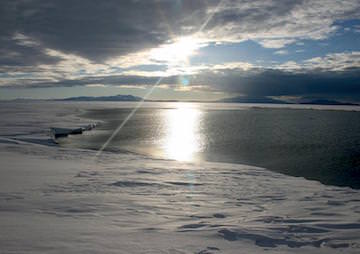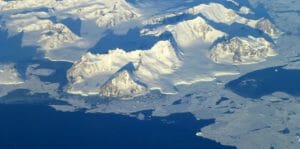Unlimited Emissions Would Result in Ice-Free Antarctica
Scientists warn that burning up the planet’s remaining fossil fuel would cause all Antarctic ice to melt and produce devastating sea level rise.
By Tim Radford, Climate News Network

The sun glistens on a vast melt pool in the Antarctic sea ice. (Eli Duke via Flickr)
This Creative Commons-licesned piece first appeared at Climate News Network.
LONDON — German and US scientists have worked out how to melt almost all the ice in Antarctica, raise sea levels by up to 60 metres, and flood cities that are now home to more than a billion people.
The answer is simple: just burn all the planet’s remaining fossil fuel resources, which would pump another 10,000 billion tons of carbon into the atmosphere in the form of the greenhouse gas, carbon dioxide.
The West Antarctic ice sheet would become unstable by the end of the century, although it might take another 10,000 years to melt the much larger East Antarctic sheet.
But the release of carbon on such a scale would mean that sea levels could rise by three metres a century — and once the planet’s average temperatures had risen beyond 2°C, the process might be impossible to stop, according to a study published in the journal Science Advances.
Much larger loss
“Our findings show that if we do not want to melt Antarctica, we can’t keep taking fossil fuel carbon out of the ground and just dumping it into the atmosphere as CO2, like we’ve been doing,” says one of the report’s authors, Ken Caldeira, an atmospheric scientist at Stanford University’s Carnegie Institution for Science, California .
“Most previous studies have focused on the loss of the West Antarctic ice sheet. Our study demonstrates that burning coal, oil and gas also risks loss of the much larger East Antarctic ice sheet.”

How Antarctic ice would be affected by different emissions scenarios (GTC = gigatons of carbon). Image: Ken Caldeira and Ricarda Winkelmann
The report’s lead author, Ricarda Winkelmann, climate system analyst at the Potsdam Institute for Climate Impact Research, says such action would cause global sea level rise on a scale unprecedented in human history.
“This would not happen overnight,” she says, “but the mind-boggling point is that our actions today are changing the face of planet Earth as we know it, and will continue to do so for tens of thousands of years to come.”
The study, although led by German scientists, started in Professor Caldeira’s global ecology lab in the US, and in every sense bears his signature. It takes a big, simple idea, strips away all the difficult short-term questions, and follows it to a logical conclusion.
“The mind-boggling point is that our actions today are changing the face of planet Earth
as we know it, and will continue to do so
for tens of thousands of years”
People working with Caldeira in the last two years have settled a number of such big and never-before-asked questions — for instance, whether geo-engineering could save the Arctic ice cap (it would not) or whether treating the ocean as a renewable energy source would actually accelerate global warming (it would).
The same style of thinking has established that it could take just 45 days for the heat from released carbon dioxide to outpace the initial combustion that released it, and that at current fossil fuel emission rates, all the ocean’s coral reefs would be at risk within this century.
The bottom line of the latest research is that unrestrained fossil fuel burning could cause extreme sea level rise over the next thousand years, and put crowded mega-cities such as New York, Tokyo, London, Shanghai and Calcutta at serious risk.
Complex calculation
The timing is no great surprise: the world’s political leaders will gather at the UN climate change conference in Paris in December to decide on an international programme to limit global warming.
But though the question the scientists asked themselves is a simple one, it still involved some complex calculation.
“It is much easier to predict that an ice cube in a warming room is going to melt eventually than it is to say precisely how quickly it will vanish,” Dr Winkelmann says.
“Our results show that the currently attainable carbon resources are sufficient to eliminate the Antarctic ice sheet, and that major coastal cities are threatened at much lower amounts of cumulative emissions.
“In a world beyond two degrees, long-term sea level rise would likely be dominated by ice loss from Antarctica.”
Your support matters…Independent journalism is under threat and overshadowed by heavily funded mainstream media.
You can help level the playing field. Become a member.
Your tax-deductible contribution keeps us digging beneath the headlines to give you thought-provoking, investigative reporting and analysis that unearths what's really happening- without compromise.
Give today to support our courageous, independent journalists.






You need to be a supporter to comment.
There are currently no responses to this article.
Be the first to respond.